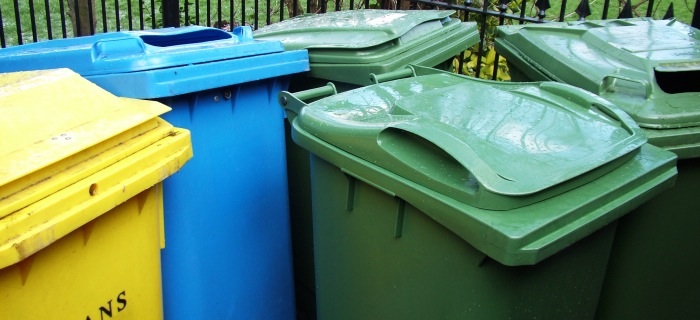Recycling

Confession time here. I'm a bad recycler. Sometimes I do okay; other times I close my eyes, assuage my guilt by telling myself I recycle more then the average person and toss things that could just as easily be recycled. Actually, not just as easily and that is the problem isn't it? Recycling isn't as easy as throwing away. It takes a bit more effort and some of us have a hard time getting started and keeping going. A good friend of mine tells me it is just a matter of organization and, after all the tricks I have learned in the last year, I'm beginning to believe her.
So how does your personal recycling center measure up? Do you have nice neat buckets and bins? Shelves and drawers? Or is your recycling area an unrecognizable, bad-smelling heap? I must admit to the latter most of the time, but with a little effort I have managed to transform my recycling pit into a practical and user-friendly system of efficiency.
Recycling bins seem to be a very popular subject. Since first putting out the call for recycling tips last spring, I've received dozens of emails over the summer from happy recyclers who offered oodles of suggestions to share on organizing your recycling zone. The emails ranged from the practical to the eccentric, but all showed me there are better ways to recycle (and keep the garage clean) than to open the door and toss in the corner.
First off, find out what your recycling centers or curbside programs accept. Some are quite extensive and others only accept certain types of paper or plastics. After checking that out and finding out what their rules are, take a close look at your trash. Are the things you generally throw away recycled in your community? If not, maybe you should try to precycle before you start recycling.
Precycling is being aware of your buying habits. It only makes sense to eliminate what garbage and recycling you can before you even bring it home--think about how much less recycling you would have to do if you reduced your output.
- Think about the packaging of what you are buying. How much of what you are paying for are you throwing away?
- Buy in bulk whenever possible.
- Look for products that you can use over and over such as real razors instead of disposable or cloth diapers instead of disposable.
- Use cloth shopping bags
- Reuse your plastic produce bags--even reusing them once halves your output.
After you make precycling a way of life, you are ready to start searching for a place to put your personal recycling center. It doesn't have to be a big area. If space is a problem try a 2 step system of recycling. Store them in a small container in the home then dump them in an outside bin. Another option for those who have a lack of space is to store them in different places in the house. For instance, put the cans under the sink, the paper in the garage and the cardboard in the laundry room. Just keep it in the same place so that everyone knows where to find them.
So exactly what should you put your recycling in? There are a lot of fancy recycling systems you can buy that can help you get organized. But really, why not get into the spirit of things and recycle? Some ideas are; sturdy cardboard boxes, laundry baskets, burlap sacks (hanging them up is another great way to save floor space) or trash cans. A lot of these items can be purchased reasonably at second hand stores. Many curbside recycling programs supply crates for your recyclable.
Okay, now you've chosen the space, the containers and you're ready for the practicals. Here is a list of tips gleaned from all the letters I received.
1. Stay on top of it! It's best to recycle immediately after you use the product. If you use a can of greenbeans, take a half a minute to cut the bottom off, rinse, smash and toss in the bin, or bag, etc. Rinse and smash the milk containers after the last drop has been poured. This keeps you from getting overwhelmed (and keeps your center from smelling like a dump).
2. Have a plan. Often times it is best to start with just one or two things and make a habit of it before moving on to another recyclable. For instance, recycle milk jugs until it become second nature then go on to glass or cans.
3. Try keeping a wicker basket at your desk to drop your waste paper in. Once it is full, simply take it to the proper bin.
4. Don't worry if you only have the room, time or energy to recycle a couple of things--every little bit helps.
5. Get your children involved. Maybe they can help search for an area or paint the bins or boxes you are going to use. The more they feel it is their program the more likely they will want to help recycle.
Teri Brown is a freelance writer and the homeschooling mother of two. Her book, Christian Unschooling: growing your child in the freedom of Christ, is now available.
